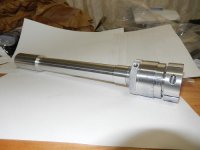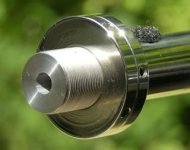Ah Gene! That's what I've been telling you for the last 6 years!!
Now to add one more part of the myth to break: The 'absolute' position of the tuner ring (zero-up,
X turn(s) off the shoulder) is only useful with respect to that set of tuner rings and the individual barrel. Because
- barrels can be different lengths,
- the threading shoulder position can be slightly longer or shorter,
- the barrel could have been indexed anywhere when it was threaded,
- the tuner threads themselves can be indexed anywhere,
- and the tuner 'zero' mark can be indexed anywhere...
the 'zero' mark is only a
RELATIVE reference for
a barrel/tuner combination.
What I came up with was a measuring method for recording my tuner settings on each barrel/action/tuner-set. In my shooting logs, I write down the tuner setting for each target shot as two numbers -- the first is the number of times the zero-ref-mark has passed top-dead-center of the barrel, turning out from the shoulder. The second is an offset from that position in thousandths of an inch as measured by appropriately scaled decals or engraved marks. A typical entry would look like 2T/+.003 (for "2 turns plus .003") or 3T/-.015 ( for 3 turns minus .015"). The first "turn" is not necessarily a full revolution -- it depends on where the zero-ref was when it locked up against the shoulder of the tuner threads.
This method gives an absolute setting that can be used to re-position the tuner on that barrel again. By noting the offsets for the first turn it can also be used to compare two different tuners on the same gun at the same position (I used this to test different sets of tuner rings). It can work for any thread pitch for comparing results for alternate tuners (my rail tuners are 32tpi, bag guns are 28tpi and 32tpi) on different guns. In short, it establishes a
RELATIVE coordinate system in .001" increments that you can use for some spreadsheet analysis across barrels, actions, loads, tuners, etc. For spreadsheet work, I usually pick 1T/+.000 as an origin. Each barrel/tuner combination has a 1T/-.0xx limit that is the shoulder lock-up) It is a simple calculation using the (thread pitch * turns) plus offset for a total absolute movement that can be correlated to whatever other factors you care to jot down (temp/humidity/pressure altitude/etc) and analyze.
I've had a hundred conversation with shooters that start, "I have my tuner set at zero, and ...". The first thing I do is try to get it through their heads is that there is nothing magic about that 'zero' reference point. The key is find a spot where it is perfectly in tune, then make very small adjustments from there.
Rod



